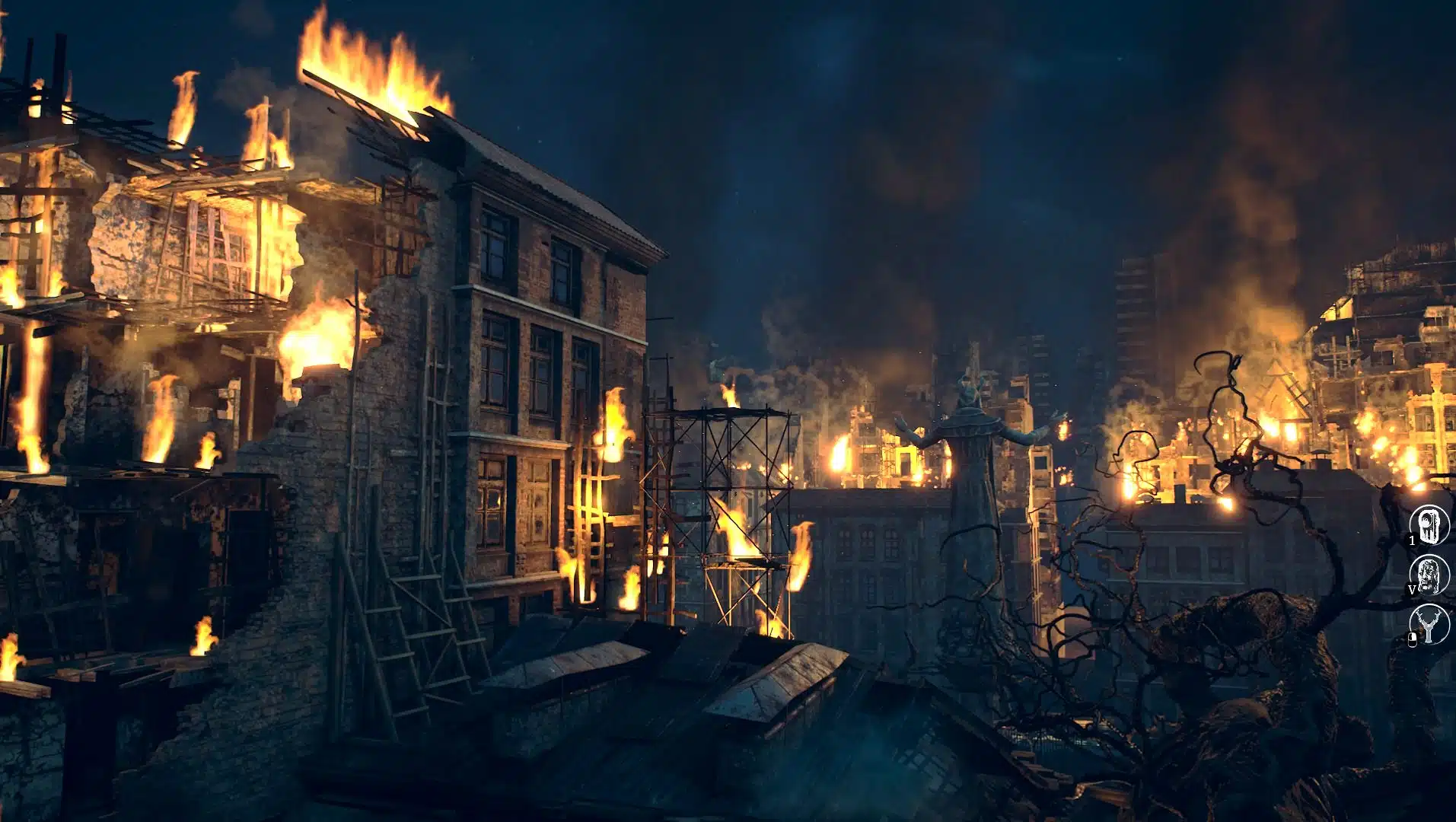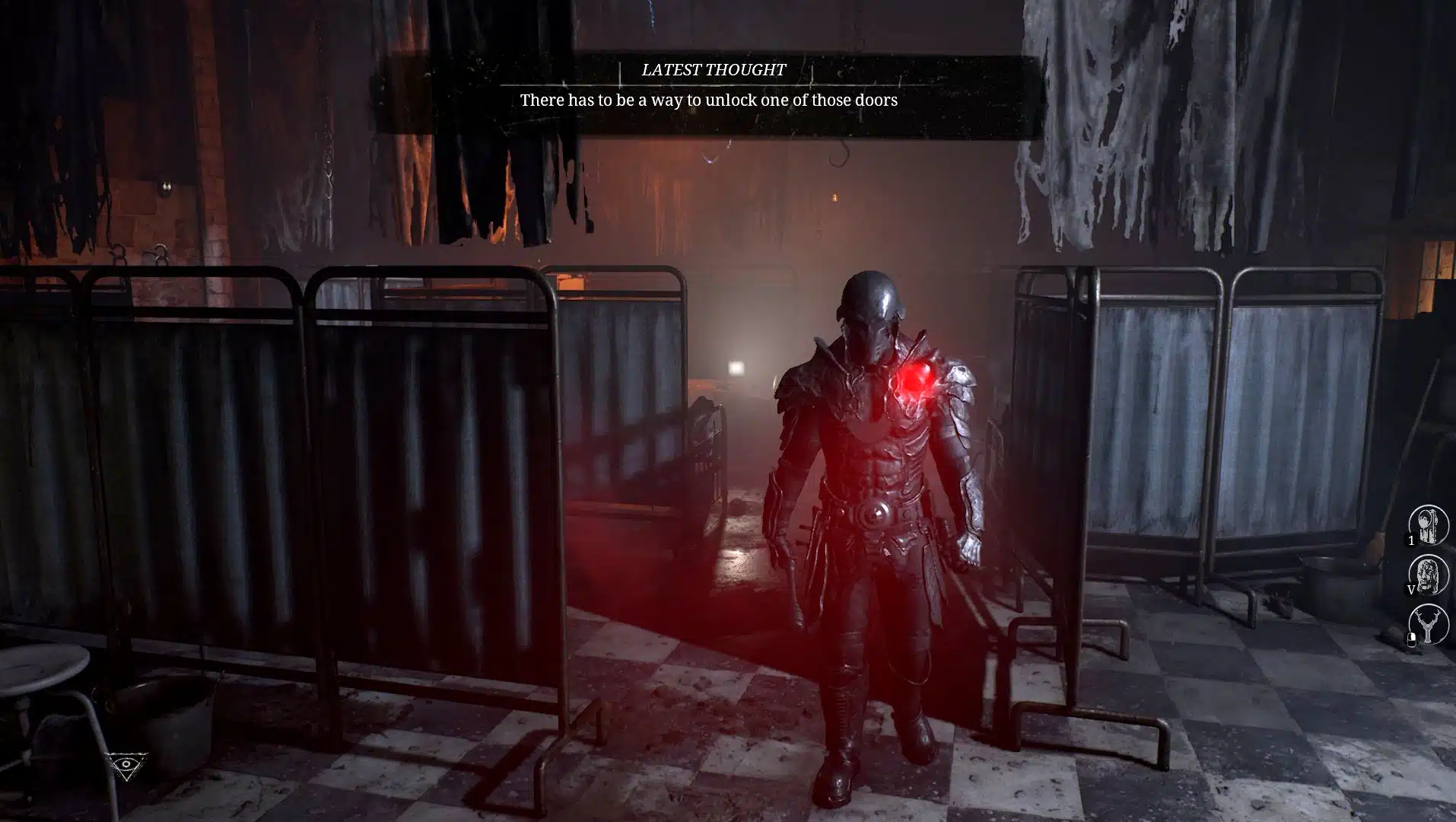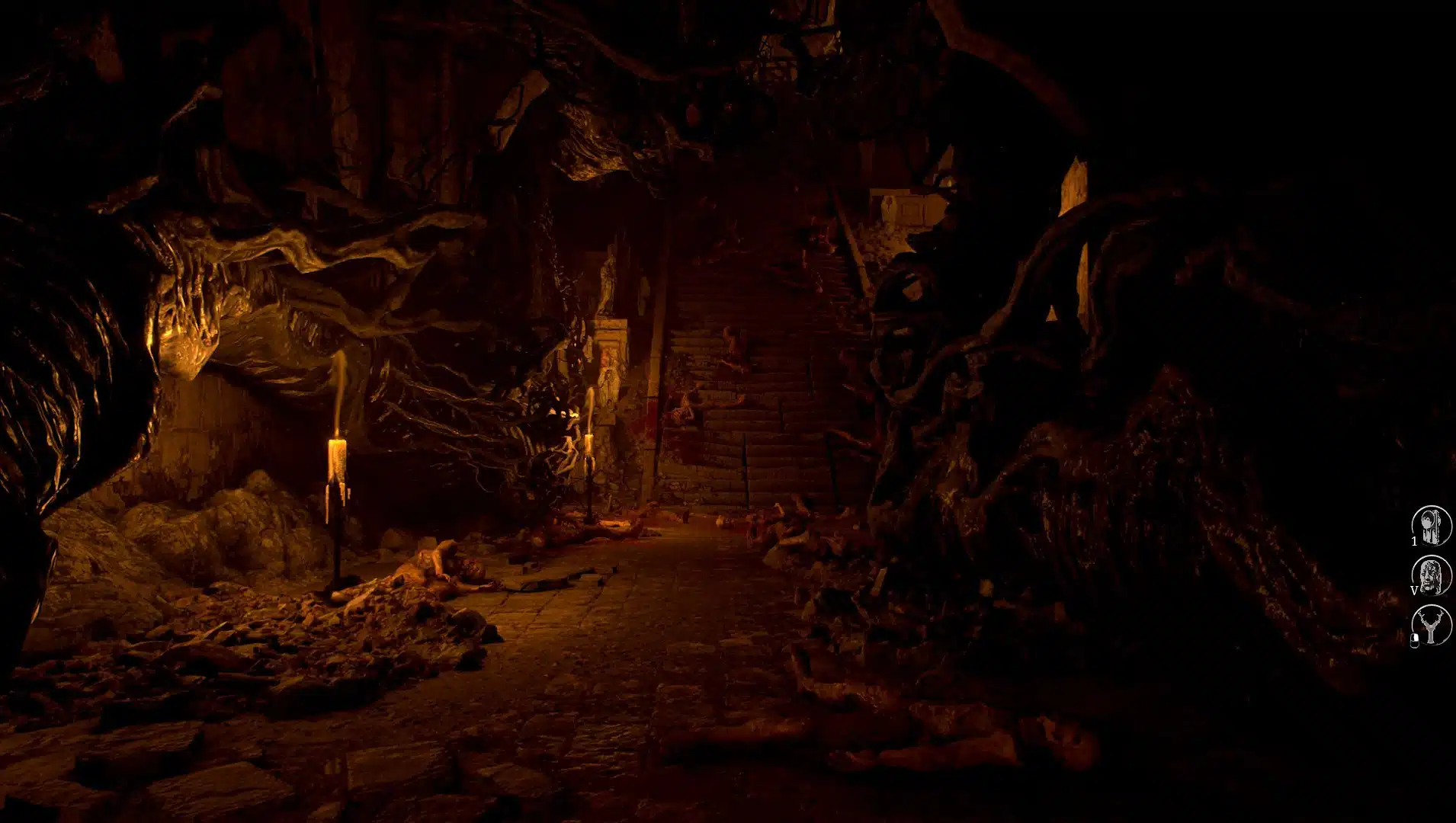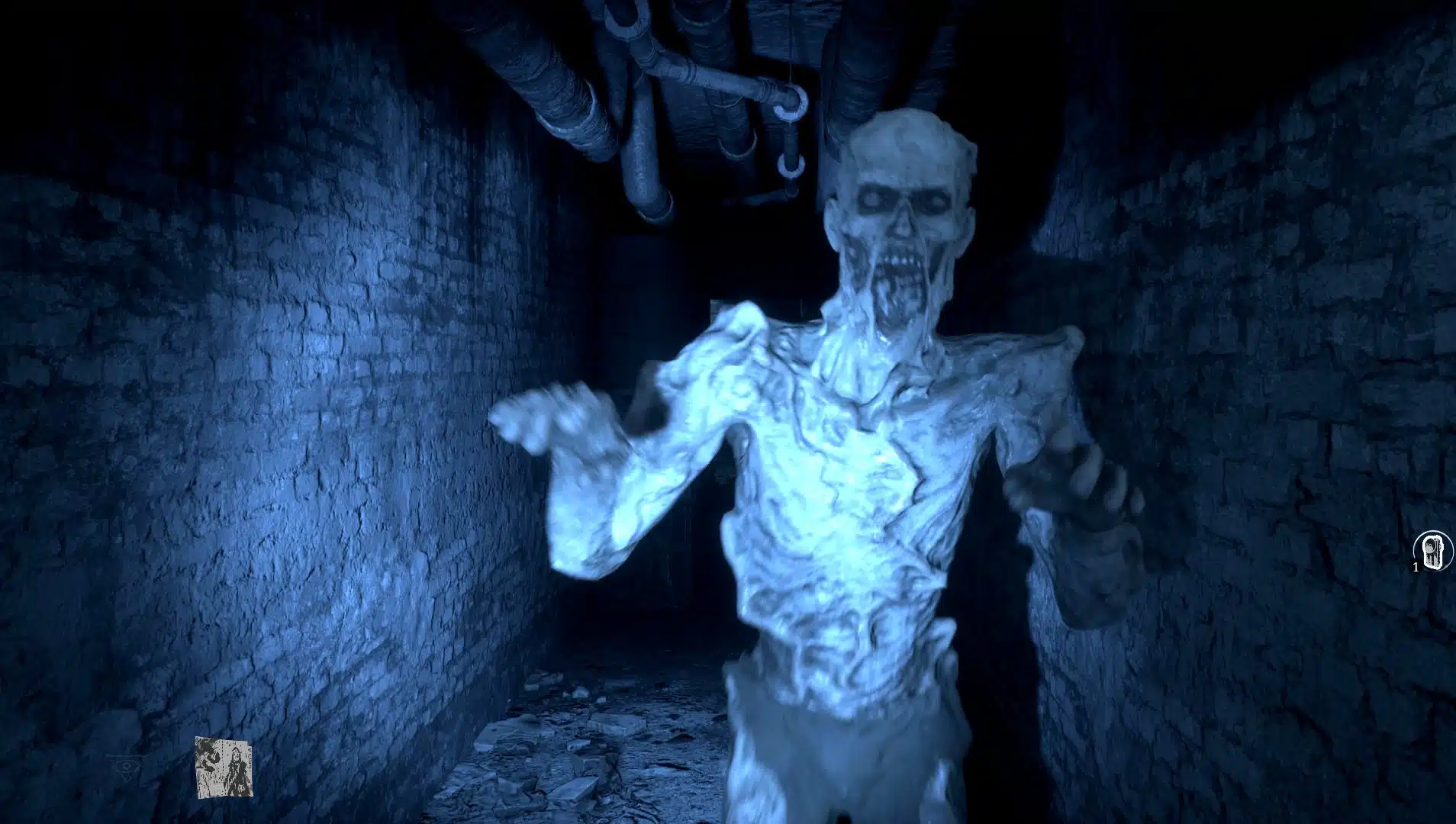A horror game deeply nested into the controversy of sects and afterlife, Unholy adds the loss of a child as the motivation for our character, Dorothea Linde, to travel between worlds. With inspiration from Silent Hill and Alone in the Dark but never coming close, this is a game at its best when focused on atmospheric exploration and puzzles, but its flirting with severely flawed stealth sections brings the whole adventure down in flames.
Hell Hath No Fury Like a Childless Mother
The impressions from our Unholy hands-on preview were positive, albeit reserved. The setup was intriguing, as the desperate protagonist accepts the offer from a stranger to bring back her dead son from this alternate world known as Eternal City. The story is intriguing before delving into predictable areas, revealing her motives to join the Spring of Eternity cult with Gabriel before deciding to flee its grasp. It was too late, and a supernatural voyage is about to begin.
Crossing from the real world into the netherworld is done via a ritual where Dorothea burns mementos. But the journey is completely linear, guided by the needs of the narrative and the increasing exposition to the secrets of both locations. The enjoyable slow-paced reality merrily prances between psychological horror and occasional jumpscares, providing an appreciated descent into creepiness and insanity that never fully materializes, instead opting for a netherworld where Solid Snake would feel right at home.

Some of the issues with Unholy is that the design alternates between competent and excessively clunky. When you’re following the beats and navigating the environment, it’s acceptable apart from failing to spot a ledge to climb or a hole to crawl into, eventually the occasional invisible wall frustrating your efforts. But Dorothea displays the agility of a sedentary mother who avoids exercise at all cost, with jumps that are barely useful to overcome anything, safe for very rare and specific occasions, and the constant will to bump into the environment and have a hard time moving around it.
Paired with the stealth sections, this becomes an infuriating exercise of trial and error. The countless ways in which these mechanics are broken are too many to describe, but the AI is what takes the otherworldly cake here, as it acts in a mix of brainless and frustrating. Take the lockers where you can hide from the guards and ghouls as an example – even if you are at an arm’s reach from your pursuer, stepping into a locker is like a safe space, instantly throwing them off. But now it’s time to be annoyed by the long waiting times, as the enemies rotate in place, ghouls twitch around, feeling like an eternity before they finally return to their post, if that happens. Exit the locker and the odds are high that you’re just going to be chased again, repeating the process.
Stealth has more issues worth noting, such as ghouls running against walls and other obstacles, ignoring mines exploding right in front of them and shots flying by, and so on. Even the mere act of descending a ladder is flawed, as Dorothea keeps staring up and disregarding the fact that ghouls may be waiting for us right below.
Since Unholy limits your movement by highlighting the few places you are able to climb or vault, there’s no room for experimentation or improvisation, forcing you to plan a route according to the few available possibilities. Dishonored this isn’t for sure.
Learning the goal of each stealth section by dying repeatedly and then attempting a run for it is likely to become your modus operandi. Except in a few moments where the game truly tries to be ingenious, such as the locked doors area where you can’t open more than two at a time, but that doesn’t make up for all the rest.
Emotion Management

Stealth plays a big part of your escapades in Eternal City, but you’re going to find a couple of devices to help you, albeit in essentially a limited way. Four emotions can be found and used with your supernatural slingshot, basically amounting to different types of ammo. Anger breaks objects in the environment, Shock destroys circuit breakers, Sadness creates a cloud of smoke to obstruct the enemies’ sight, and Desire attracts enemies to a given location.
One of the issues is that you don’t select your ammo type with a single keypress, you must cycle through all of them. In the heat of the moment this becomes fuel for chaos, as you mistakenly select an emotion that isn’t going to help you out, while the ghouls draw near. The slow rate of fire is also aggravating, something that the extremely basic skill tree doesn’t help much with. Since enemies kill you with a couple of hits, sometimes as you try to escape the first one, and you have no melee attack, your only resort is to attract them to a mine, one that may eventually kill you as well if you’re not careful.
Die and you are placed at a checkpoint that is designed to test your patience, forcing a repetition of processes that makes Unholy feel like literal hell, a mother’s supernatural struggle that somehow is making us reconsider its worth, not for lack of trying. May Gabriel hold tight as we watch another ghoul twitch its head from the safety of our locker for an uncertain time.
Masks are another feature that feel little more than a gimmick. Every so often you will create a mask out of a grand total of three, one of them available very late in the game. From seeing interactive objects to navigating through poisonous clouds or detecting enemies in thermal vision style, these can be useful but since you can’t use it along with your slingshot, it requires some unwarranted juggling.
Unholy is plagued by other issues that hurt your enjoyment. Grammar errors aren’t uncommon, clipping through walls and gratings is a thing, but the most flagrant situation and one that frustrated me throughout the seven-hour adventure was that the interaction points often fail to register. I could be close to an object or door and the interaction point didn’t appear, or was just randomly flickering in and out of existence, preventing me from triggering it. This may be related to alt-tabbing or some performance issue, but it’s enough of a negative point that surely will happen to more players.
To Hell and Back

Unholy’s atmosphere has its moments, bolstered by a sound design that isn’t shy on the choirs and tension. Dorothea’s accelerated breathing is interesting to listen, although it drags on for too long and not quite the best thing to do when hiding in a locker, but game logic, right? Wooden acting during cutscenes and general clumsy voice work that often chews up the scenery don’t do the game any favors.
Unholy started on the right foot, with a setup that wasn’t too far from contemporary horror movies, but you’ll be better off by waiting for the release of Silent Hill 2 Remake. The predictable descent into madness wasn’t entirely successful, as the netherworld is little more than your average city in ruins and an excuse to add broken stealth elements into what could have been an accomplished narrative-driven mystery. This is a game that works better when it isn’t trying to tick boxes left and right, but once you step foot into the Eternal City, it drags at snail pace and rewards you with recurrent death and frustration. A mother’s struggle it may be, but making it a player’s struggle as well isn’t exactly what horror games should do.
Score: 5/10
Pros:
- First chapter is a moody and immersive horror experience
- Decent gameplay when focusing on exploration and puzzles
Cons:
- Eternal City is literal stealth hell with broken mechanics
- Enemy AI is bare-bones
- Dorothea doesn’t have the agility this task requires
- Lack of polish and bugs
Unholy review code was provided by the publisher. You can read MP1st’s review and scoring policy right here.

NICE